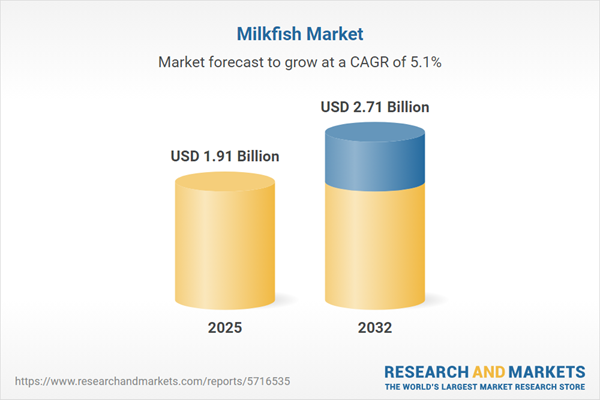Speak directly to the analyst to clarify any post sales queries you may have.
Senior decision-makers in the milkfish market must stay ahead of shifting regulatory requirements, evolving consumer preferences, and rapidly changing distribution models. This market briefing provides clear, actionable insight to guide leaders as they navigate operational complexities and capitalize on sector opportunities.
Market Snapshot: Global Milkfish Market Size and Growth
The global milkfish market achieved a valuation of USD 1.81 billion in 2024 and is projected to reach USD 1.91 billion by 2025, corresponding to a CAGR of 5.12%. This growth is underpinned by significant investments in advanced processing technologies, expansion of product diversification strategies, and intensifying competition across global and regional landscapes. Companies are implementing robust supply chain frameworks, modifying pricing strategies, and prioritizing sourcing initiatives to develop resilient market positions. Ongoing regulatory adaptation and shifts in consumer expectations are integral to competitive strategies, necessitating continual monitoring of policies and industry sentiment.
Scope & Segmentation: Actionable Market Frameworks
This report offers a dynamic, senior-executive-focused segmentation framework, enabling targeted resource deployment and timely response to market shifts. Each segment arms leaders with intelligence fundamental for both near-term operational optimization and long-range planning within the milkfish sector.
- Product Form: Canned, fresh-cut, whole fresh, frozen fillet, portioned frozen, whole frozen, and value-added formats—including ready-to-cook and ready-to-eat—address the needs for convenience, extended shelf life, and application versatility.
- Distribution Channel: Hypermarkets, supermarkets, traditional retail, direct-to-consumer models, and e-commerce accelerate market reach and foster deeper consumer engagement, both in mature and emerging territories.
- End User: Foodservice providers and households present differing requirements in terms of convenience, nutrition, and quality, shaping tailored value propositions and product development initiatives.
- Farming Method: Extensive, intensive, and semi-intensive approaches deliver operational benefits through varied technology adoption, efficiency profiles, and alignment with evolving sustainability and compliance benchmarks.
- Regional Coverage: Americas, Europe, Middle East & Africa, and Asia-Pacific each face distinct regulatory, logistical, and market demand contexts, making adaptive regional strategies crucial for competitive positioning.
- Leading Companies: Century Pacific Food, Mega Global Corporation, CDO Foodsphere, Universal Canning, Aquamarine Products, Frabelle Fishing Corporation, Charoen Pokphand Foods, and PT Central Proteina Prima Tbk drive innovation and set best practices in development and sector logistics.
Key Takeaways: Strategic Insights for Senior Decision-Makers in the Milkfish Market
- Product portfolios are evolving to reflect health and wellness considerations, increasing relevance for both retail and foodservice clients and contributing to the alignment with changing consumer diets.
- Market urbanization is boosting demand for ready-to-cook and ready-to-eat solutions, encouraging transformation in packaging innovations and distribution strategy adaptations.
- Supply chain transparency and traceability have become pivotal in building consumer trust and ensuring compliance with safety and authenticity standards.
- Technology-driven digitalization is enhancing logistics and inventory management, enabling companies to respond with greater agility to dynamic market conditions and improve overall resource allocation.
- Direct-to-consumer and digital sales platforms are changing brand approaches, increasing marketplace visibility, and supporting engagement strategies tailored for market variation.
- Innovation in farming and distribution methods is increasing organizational resilience, enabling companies to adapt to regulatory and demand fluctuations and sustain their market presence.
Tariff Impact: Navigating Regulatory Changes
With new tariffs due to take effect in the U.S. on imported milkfish in 2025, companies must reassess supplier partnerships, renegotiate agreements, and reinforce logistics to maintain accessible, profitable supply channels. These regulatory shifts place greater emphasis on strategic risk management to support uninterrupted market participation throughout the transition period.
Methodology & Data Sources
The findings in this report are grounded in direct engagement with stakeholders, in-depth evaluation of supply chain components, and ongoing market surveillance. Analytical frameworks such as SWOT and PESTLE underpin the recommendations, reinforcing the credibility of insights for executive decision-making.
Why This Report Matters
- Equips senior leaders to proactively address regulatory uncertainty and operational disruption using structured market frameworks and reliable data.
- Supports deployment of adaptable technology and strategic planning to match varied regional and segment demands.
- Enables alignment of strategies and resources through unbiased intelligence and actionable insights as client requirements evolve.
Conclusion
This report empowers leaders in the milkfish sector to make informed, agile decisions and strengthen resilience in the face of industry challenges, enabling sustained competitive advantage and growth.
Additional Product Information:
- Purchase of this report includes 1 year online access with quarterly updates.
- This report can be updated on request. Please contact our Customer Experience team using the Ask a Question widget on our website.
Table of Contents
3. Executive Summary
4. Market Overview
7. Cumulative Impact of Artificial Intelligence 2025
List of Figures
Companies Mentioned
The companies profiled in this Milkfish market report include:- Century Pacific Food, Inc.
- Mega Global Corporation
- CDO Foodsphere, Inc.
- Universal Canning, Inc.
- Aquamarine Products, Inc.
- Frabelle Fishing Corporation
- Charoen Pokphand Foods Public Company Limited
- PT Central Proteina Prima Tbk
Table Information
| Report Attribute | Details |
|---|---|
| No. of Pages | 196 |
| Published | November 2025 |
| Forecast Period | 2025 - 2032 |
| Estimated Market Value ( USD | $ 1.91 Billion |
| Forecasted Market Value ( USD | $ 2.71 Billion |
| Compound Annual Growth Rate | 5.1% |
| Regions Covered | Global |
| No. of Companies Mentioned | 9 |









